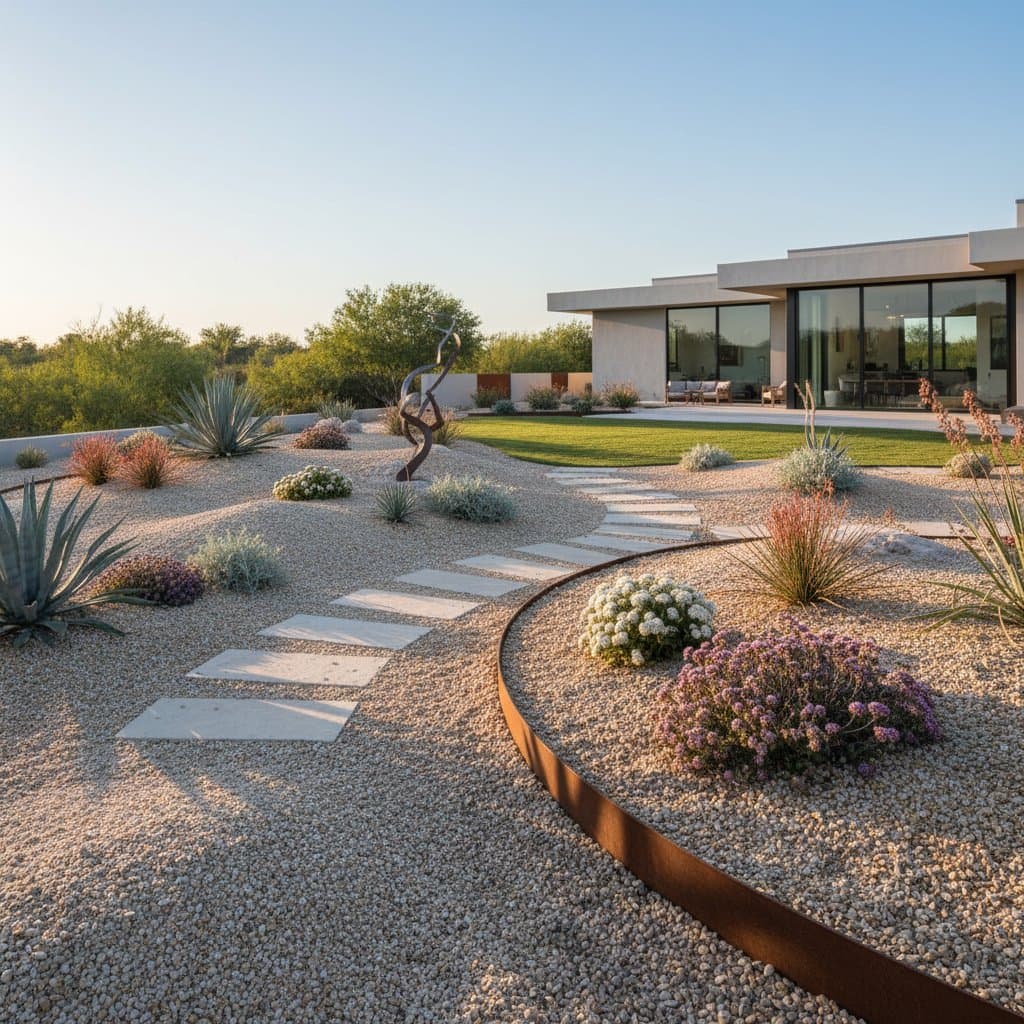The Benefits of No-Mow Gravel Gardens for Time and Cost Savings
A vibrant green lawn appears appealing, yet it demands substantial water, fuel, and labor. In California and similar arid areas, numerous homeowners embrace the liberty and elegance of no-mow gravel gardens. These designs integrate artistic textures, water conservation, and simple care, providing an intelligent approach for those seeking to decrease tasks while preserving allure.
The Advantages of Gravel Gardens
Gravel gardens extend beyond mere ornamentation. They form an effective landscaping framework that nurtures drought-resistant vegetation while controlling weeds and moisture consumption. Gravel serves as mulch and aesthetic feature. It protects soil, halts erosion, and ensures superior drainage. In hot regions, this setup alleviates pressure on plants sensitive to waterlogged conditions.
A thoughtfully arranged gravel garden tempers the visual warmth of an area. Gentle gray or beige gravel pairs elegantly with succulents, indigenous grasses, and blooming perennials. This style aligns naturally with California's environment, characterized by prolonged dry seasons and scarce precipitation, rendering conventional lawns challenging to uphold.
Steps for Achieving Low-Maintenance Gravel Gardens
Prior to placing any gravel, develop a detailed strategy. Initial preparations influence the garden's ongoing ease of care.
- Eliminate or suppress current grass. Turf roots vie for resources. Employ a sod cutter, layer mulch sheets, or apply solarization techniques to prepare the site completely.
- Add durable borders. Opt for metal or stone edging to contain gravel away from walkways or terraces and maintain sharp boundaries.
- Position permeable weed fabric. This material blocks most unwanted growth while permitting soil access to oxygen and water. Steer clear of plastic liners, which retain moisture and harm root systems.
- Select appropriate gravel dimensions. Smaller pea gravel offers a comfortable walking surface, whereas angular crushed stone provides stability on inclines or access routes. Avoid overly fine varieties that may pack densely and impede drainage.
Consider soil testing to adjust pH levels for optimal plant health. Amend with compost if needed to enrich the base without promoting excess moisture retention.
Selecting Resilient, Drought-Tolerant Plants
Plants define the essence of a gravel garden. Choose varieties adapted to sparse, fast-draining soil and extended periods without rain. Recommended selections encompass:
- Lavender, valued for its aroma and attraction to pollinators
- Salvia, noted for vivid hues and durability
- Kangaroo paw, prized for distinctive form
- Thyme or sedum, ideal as ground covers
- California fescue or blue oat grass, adding dynamic motion and visual interest
Arrange plants by comparable hydration requirements, providing adequate spacing for maturation. Gravel can amplify warmth, so ensure sufficient root expansion area for temperature regulation. Implement drip systems or targeted watering in the initial phase to encourage deep rooting; subsequently, most specimens require little intervention.
Incorporate a mix of evergreen and seasonal bloomers to sustain year-round appeal. For example, pair low-water shrubs like manzanita with accent grasses for layered depth.
Realizing Savings in Water, Time, and Expenses
After rooting, a gravel garden uses far less water than a typical lawn. Reductions appear promptly in monthly statements. The absence of mowing, trimming, or nutrient applications also lowers energy consumption and tool investments. Freed hours allow greater enjoyment of the outdoor area rather than labor within it.
Gravel gardens endure reliably. Unlike decomposing organic covers that demand renewal, gravel retains form across years. Light raking maintains tidiness. Emerging weeds pull effortlessly from the granular medium.
Quantify benefits by tracking pre- and post-installation utility data. Many users report 50 to 70 percent drops in irrigation costs, alongside eliminated weekly chores.
Practical Design Concepts for Daily Use
An effective gravel garden transcends basic rocks and flora. It evolves into a functional extension of living spaces. Fashion meandering trails guiding toward seating or a gathering fire feature. Incorporate substantial rocks or boulders as focal points. Blend surfaces by combining polished gravel with textured slabs or finely ground granite. Discreet illumination nestled among greenery fosters nighttime allure without overwhelming brightness.
In compact lots, form a gravel-enclosed patio flanked by elevated beds to convert a burdensome zone into a serene haven. On expansive grounds, integrate gravel sections with wildflower meadows or canopy trees to craft a multifaceted, nature-inspired layout.
Experiment with color schemes, such as warm terracotta gravel against silver-leafed plants, to personalize the vibe. Add reflective elements like polished stones to brighten shaded corners.
Sustaining and Appreciating Your Effortless Garden
A no-mow gravel garden yields returns through diligence and foresight. The opening months focus on assembly and vegetation acclimation, yet upkeep soon diminishes to essentials. Regular checks verify border integrity and plant equilibrium. Gradually, stone shades and leaf tones harmonize, evoking a serene, enduring ambiance.
The true value emerges in routine experiences. Less effort on irrigation and cutting translates to more moments of relaxation. The crunch of footsteps on gravel, the fragrance of sun-heated herbs, and the assurance of an attractive, eco-friendly yard underscore how informed choices enhance well-being and tranquility.

